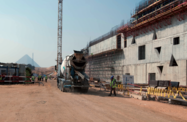Strong demand and positive market conditions are driving investment in the residential segment of Egypt’s real estate sector.

The Egypt Property Show (EPS), held in Dubai in April, posted a sharp increase in property sales to $110m, doubling last year’s total.
The event, which provides Egyptian property developers and real estate firms with a platform to reach potential foreign investors, was attended by GCC nationals and Egyptian expatriates residing in the UAE.
The EPS is expected to visit the UK, US and Kuwait before the end of the year, with officials forecasting full-year sales of $250m.
Real estate firm Propertyfinder Egypt also reported a spike in the number of listings on its portal in the first quarter of 2018. Registered properties increased by 133% year-on-year, rising from 46,528 to 108,571.
New supply reflective of positive investor environment, strong sector performance
The high level of investor interest is in part due to a push by the government to attract greater foreign investment in real estate.
In June last year it implemented a new investment law guaranteeing fair and equitable treatment for both foreign and local investors, the right to repatriate profits or receive international finance without restrictions, and a residence permit for the duration of investment projects, among other measures.
It is also reflective of the residential segment’s resilience in the face of challenging broader economic conditions in recent years. While the effects of the flotation of the Egyptian pound in late 2016 and subsequent currency devaluation increased construction costs for developers and exerted downwards pressure on disposable incomes in 2017, demand for real estate in Cairo increased significantly, with many seeing it as a stable investment opportunity.
Apartment and villa sales increased by 59% and 16%, respectively, in 2017, according to an annual report by real estate firm JLL. However, creeping inflation and the weaker pound weighed on spending power in the rental segment, which saw a decline of 24% for apartments and 3% for villas.
This performance is expected to continue in 2018, as higher GDP growth and improved consumer sentiment on the back of lower inflation encourage an uptick in rentals and prompt developers to push ahead with new projects. “With new developers entering the market and the level of competition increasing, it is important to have a product that matches the demand, and at the right price” Mohammed Allam, CEO of Hassan Allam Properties told OBG, “There is a lot of opportunity, but the challenge for many will be effectively managing costs when price of land can reach up to 40% of the end price of a unit.”
GDP growth is forecast to reach 5.2% this year and 5.5% in 2019, up from 4.3% last year, according to the IMF, and in April inflation fell to its lowest rate in almost two years, at around 13%.
As in many of the world’s mega-cities, demographics will remain a fundamental driver of housing demand. Egypt has a population of around 97m – more than 20m of whom live in Cairo – and an average annual growth rate of 2.4% per year, according to the Central Agency for Public Mobilisation and Statistics.
Although 10,000 units were added to residential stocks in 2017, and deliveries of previously announced projects could add a further 70,000 units within gated residential communities over the next three years, according to real estate firm JLL, this figure falls well short of the estimated annual demand of 500,000 new homes.
Construction of new cities designed to ease congestion
Much of the new supply entering the market over the next few years is located in and around the New Administrative Capital under development some 45 km east of Cairo. The $45bn project is the government’s response to rising congestion in and around Greater Cairo, where the population is expected to balloon to 40m by 2050.
Inaugurated in October last year, the new city will house key public institutions, including the Parliament, and will span 700 sq km, with the capacity to house some 5m people by 2050. The first stage is expected to be complete by 2019.
Other new cities are also being built to accommodate population growth, such as New Mansoura City. Built on an area of 1680 ha and at a cost of $3.4bn, the city will comprise a series of residential, tourist and industrial developments, with an estimated future population of 1.5m.


